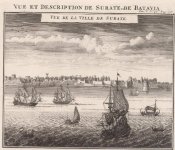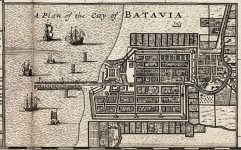The founding of Batavia by the Dutch in 1619, on the site of the ruins of Jayakarta, led to the establishment of a Dutch colony; Batavia became the center of the Dutch East India Company's trading network in Asia. Monopolies on local produce were augmented by non-indigenous cash crops. To safeguard their commercial interests, the company and the colonial administration absorbed surrounding territory.
KD: One has to appreciate all of them canals them Dutch dug out in Indonesia, as well as all of them buildings they built 7k miles away from home.
Or may be we should start paying closer attention to this downplayed locality called Jayakarta?
- The population of the Dutch Republic in 1700 was 1,794,000 people. Allegedly, of course. And where is Indonesia? Yup, 7k miles as the crow flies. What do them Dutch do? They go, and they conquer Indonesia. Right? With how many people they do that?
7k miles: Amsterdam to Jakarta

Jakarta is Indonesia's capital and largest city. Historical evidence from Jakarta dates back to the 4th century CE, when it was a Hindu settlement and port. The city has been sequentially claimed by the Indianized kingdom of Tarumanegara, the Hindu Kingdom of Sunda, the Muslim Sultanate of Banten, and by Dutch, Japanese and Indonesian administrations.
- The Dutch East Indies built up the area before it was taken during World War II by the Empire of Japan and finally became independent as part of Indonesia.
1605
Them Dutch had to be some outstanding individuals. Travel the world, conquer and build had to be their Motto. Anyways, here we have a few depictions of the future Jakarta.KD: One has to appreciate all of them canals them Dutch dug out in Indonesia, as well as all of them buildings they built 7k miles away from home.
Or may be we should start paying closer attention to this downplayed locality called Jayakarta?



